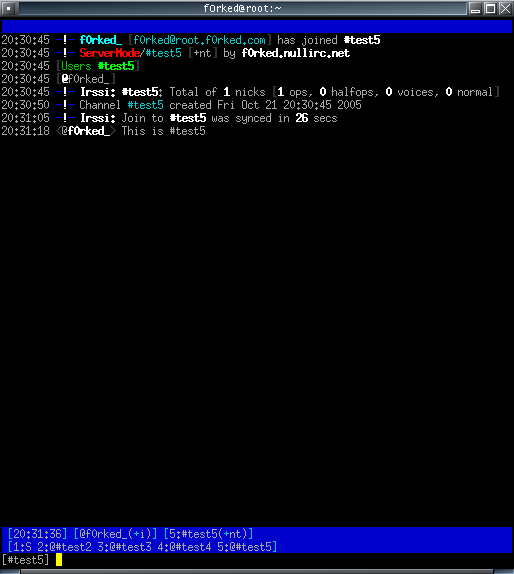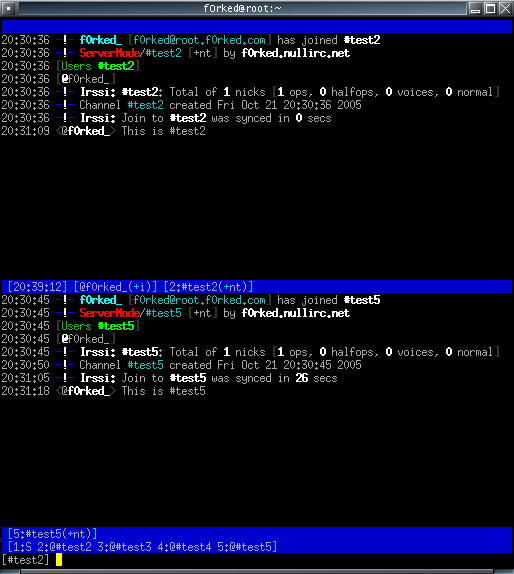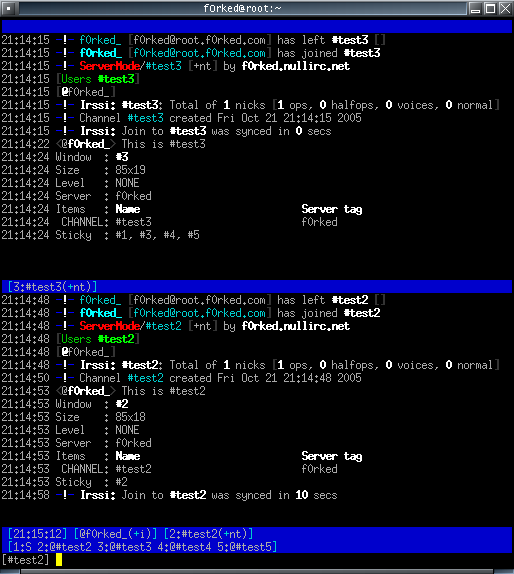An Illustrated Guide to Split Windows in Irssi
The ability to create “split” windows in Irssi is one of its most useful, but confusing, features. This guide is intended to educate you on how to create, manipulate, and manage the splitting features in Irssi.
For the purposes of this guide, I will be using the default Irssi theme (the one with the blue bars) on a black background. This will make it easier to see where the containers exist. First and foremost, there is a small set of terms which are crucial to understanding the rest of this guide:
- Screen: The entire visible Irssi entity. Everything seen inside of the terminal border will be called the ‘screen’.
- Container: A visible, potential location for a window. Containers are visible portions of the screen. Each container contains exactly one visible window.
- Item: A channel, query, or status.
- Window: An entity that displays zero or more items. Windows can be
itemless. (
/window new splitwill create a new container and a new itemless window) - Sticky: A property applied to windows. “Sticky” windows are bound to their containers. “Non-sticky” windows are free to move around to multiple containers. That is, a sticky window that is invisible will always show up in the same container. A single container can have multiple windows “stuck” to it, but a window can only be “stuck” to zero or one containers.
It is not expected for you to be very comfortable with these terms at this point. However, as you read through the guide, refer to this list of definitions often.
Now, open Irssi. Connect to a server and join your channels. By default, Irssi obviously has only one container (it must have at least one, otherwise nothing would be on the screen), and no windows are initially set sticky.
For this guide, I will be using the channels #test2, #test3, #test4, and
#test5. The numbering starts at two to keep in sync with the window reference
numbers (the status window is window 1).

You can see from the above screenshot that 4 channels have been joined. The
status window is named “S” and is window #1. The current window is window
5, which has the item #test5. Notice that the only visible window is
window 5. The other 4 windows (1,2,3,4) are not visible. They are called
hidden windows. To clear any confusion, there are only two types of
windows: visible and hidden. A “split” window technically does not exist. In
the terms of this guide, the more correct term would be a “split screen”. The
entity that Irssi calls a “split window” is known as a container here.
Tip: Learn how to add a statusbar containing your window list on my guide to irssi and screen.
At this point, you should be comfortable with the fact that Irssi starts with one container, which contains one visible window. Multiple containers means multiple visible windows. Now it is time to create another container. The current window I am in is window 5, and I want to be able to simultaneously see window 2. This is done by using:
/window show 2

As you can see, the new container with #test2 formed above the container with
#test5, and [the window containing] #test2 became the active window. By
Irssi’s definition, a “split window” refers to the window that is thrown into a
newly formed container. In this case, the new container is the portion of the
screen above the blue line in the middle of the screenshot. Essentially, it is
the top half of the screen.
By default, Irssi turns on the “autostick_split_windows” option. Having this
on is a generally good idea, as long as you understand what it does. If you
have this option enabled (which you probably do), window 2 is now stuck to
the top container. This means that window 2 will always appear in the top
container and never in the bottom container. The other four windows are
non-sticky and do not have a set container, so they are free to move around
to whatever the active container is. Non-sticky windows also tend to stay in
containers that have no windows stuck to them (notice ‘containers’ is plural:
there can be multiple containers with no windows stuck to them).
To illustrate this idea, set the newly contained window as nonsticky and explore the consequences of not having sticky windows. To do this, type:
/window stick 2 off
You should still have only two windows visible: 2 and 5. If window 2 is the
active window, use Alt-3 to switch to window 3 in that container. You
will then have windows 3 and 5 visible. Next, use Alt-5 to switch to window
5. You will still have the same windows visible, but window 5 will become the
active window. Now, because window 2 was unstuck, use Alt-2 to switch to
it. You should notice that window 2 is now in the bottom container. Most sane
people would prefer windows to not jump around like this, which is why they can
be assigned to specific containers. With window 2 as the active window in the
bottom container, use /window stick (or /window stick 2). This will stick
window 2 to the bottom container, essentially anchoring it. If you use Alt-3
or Alt-5 now, they will both appear in the top container.
Thus, a sticky window will not be replaced in its container by a non-sticky window. The non-sticky window will be displayed in a container with no windows stuck to it. If, however, there are no containers with no windows stuck to them (that is, all containers have at least one window stuck), the requested non-sticky window will become visible in the current container (the container with the active window).
“Sticky-ness” of windows makes sense, but may take time to get used to. The windows currently stuck to a container can be easily discovered by typing, in the window in the current container:
/window
The result will look something like this:

The numbers next to the word “Sticky:” are the reference numbers of the windows stuck to that particular container, not the various windows marked sticky. In the screenshot, you can see that window 2, #test2, is stuck to the bottom container, and the other 4 windows: 1,3,4,5 are stuck to the top container. In this scenario, the only window that will ever appear in the bottom container is window 2, since all windows are sticky and the only sticky window in the bottom container is window 2.
Rules
The following set of rules dictate what you can and cannot do with multiple containers in Irssi.
Rule 1
Irssi cannot do vertical splits, only horizontal splits. That is, windows can only be arranged from top to bottom, never from side to side.
Rule 2
You cannot use /window show # or /window hide # on sticky windows. Doing so
would force a window that is stuck to another container into a new container. A
remedy for this is explained below.
You also cannot use /window show # from within a container with at least one
window stuck to it. That is, if I were to use /window stick 4 off from the
bottom container in the scenario above, and then /window show 4 to try to
create a new container and put window 4 into it, Irssi would spit out an
error. I believe this is a bug.
A violation of rule 2 will result in the following error:
You can't show sticky windows (use /WINDOW STICK OFF)
Rule 3
With the Irssi setting autostick_split_windows on, new windows created
inside a container with at least one window stick to it will be automatically
be made sticky. This is true even for one container. Try closing all windows
(which will force the screen down to one container with the status window
inside), set the status window as sticky if it is not already with /window
stick 1, then join a channel. Use /window and you will find that window 2
will be sticky.
Rule 4
Closing a sticky window that is the only window stuck to a container will cause that container to disappear.
Rule 5
Using /window move UP|DOWN on a container with a sticky window to a container
without any sticky windows will remove the stickyless container from the
screen. The resulting container will have no sticky windows.
Rule 6
Using /window move UP|DOWN on a container with no sticky windows to a
container with a sticky window will remove the stickyless container from the
screen. The resulting container will contain all sticky windows.
Rules #5 and #6 hold true regardless of the setting of
autostick_split_windows.
Rule 7
Using /window stick # on a visible window that is in another container will
remove the other container, and the window will be stuck to the current
container.
Manipulation of splits
-
/window show #
Create a new container and put window#in it. See rule 2. -
/window hide #
Remove the container containing window#and hide#. See rule 2. -
/window move up
Move the current window in the current container to the container above. See rules 5 and 6. -
/window move down
Move the current window in the current container to the container below. See rules 5 and 6. -
/window new [split]
Create a new window. Ifsplitis specified, the new window will be created in a new container, and will be stuck to the new container ifautostick_split_windowsisON. The new window is itemless. -
/window balance
Make all containers the same height. -
/window grow [<lines>]
Increase the height of the current container by<lines>. If<lines>is not specified, it is assumed to be 1. -
/window shrink [<lines>]
Decrease the height of the current container by<lines>. If<lines>is not specified, it is assumed to be 1. -
/window size <lines>
Set height of current container to<lines>. -
/window stick [<#>] [ON|OFF]
If#is not specified, it is assumed to be the active window. IfON/OFFis not specified,ONis assumed. This command either sticks or unsticks a window. If/window stick # onis used, window#will be stuck to the current container. If#was already stuck to another container, it will be restuck to the current container. It does not have to be unstuck from the other container first.
Tips
Tip #1: In order to not violate rule 2, the current container needs to have
zero windows stuck to it, and the target window to be shown or hidden must be
non-sticky. Well, what if you have 35 windows with one container and you’re
trying to make a new container? Do you have to unstick all your windows first
before you can make a new container? If you want to use /window show #,
yes. But, there is a workaround: /window new split.
This will create a new container with a new itemless window, without having to
unstick all windows first. Once this command is executed, you can use /window
stick # to stick some window # to the new container. You will still have an
itemless window with this method, but you can close it with /window close
(/wc).
Tip #2: Use a split window to log your hilights. This is described in my guide to Irssi and screen.